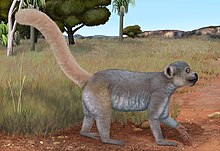古狐猴属
| 古狐猴属 化石时期:全新世
| |
|---|---|

| |
| 爱德华古狐猴(A. edwardsi)复原图 | |
绝灭(1047-1280年)
| |
| 科学分类 | |
| 界: | 动物界 Animalia |
| 门: | 脊索动物门 Chordata |
| 纲: | 哺乳纲 Mammalia |
| 目: | 灵长目 Primates |
| 科: | †古狐猴科 Archaeolemuridae |
| 属: | †古狐猴属 Archaeolemur Filhol, 1895 |
| 种 | |
| |
| 异名[1] | |
| |

古狐猴属(学名:Archaeolemur)为已灭绝的狐猴,包含有两种:爱德华古狐猴(A. edwardsi)及古狐猴(A. majori)[2]。
描述[编辑]
古狐猴属于全新世时广泛分布于马达加斯加岛各地,于全岛几乎都可发现化石,广泛的地理分布与短暂的生存年代肇因于它们身为泛化种的特性。它们的体重约介于15至35千克(33至77磅),为半地栖性的狐猴,主要栖息于地表,但也擅长于树上活动[3]。尽管几乎都于地面生活,古狐猴却不像猕猴或狒狒(科学家多半用这两者与古狐猴做比较)那么擅于行走[4];相较于几乎完全地栖性的狒狒,古狐猴具有较为粗短的四肢、较小的手指、及较宽的躯干。古狐猴被认为具有十分多样化的食性,包括种子及各种疏林草原的植物[5],古狐猴具有较大的门牙可用于移除这些种子及果实上的硬壳或外皮[4]。广适性的适应也解释了为什么它们是最晚绝种的亚化石狐猴之一[2]。
灭绝[编辑]
分类学[编辑]
参考文献[编辑]
- ^ McKenna, MC; Bell, SK. Classification of Mammals: Above the Species Level. Columbia University Press. 1997: 335. ISBN 978-0-231-11013-6.
- ^ 2.0 2.1 Jungers, W. L.; et al. The hands and feet of Archaeolemur: metrical affinities and their functional significance (PDF). Journal of Human Evolution. 2005, 49 (1): 36–55 [2008-08-22]. PMID 15989943. doi:10.1016/j.jhevol.2005.03.001. (原始内容存档 (PDF)于2017-08-08).
- ^ Hamrick, M. W.; Simons, E. L.; Jungers, W. L. New wrist bones of the Malagasy giant subfossil lemurs. Journal of Human Evolution. 2000, 38 (5): 635–680. PMID 10799257. doi:10.1006/jhev.1999.0372.
- ^ 4.0 4.1 Simons, E. L. Lemurs: Old and New. Goodman, S. M.; Patterson, B. D. (编). Natural Change and Human Impact in Madagascar. Washington and London: Smithsonian Institution Press. 1997: 142–166.
- ^ Godfrey, L. R. Adaptive diversification of Malagasy strepsirrhines.. Journal of Human Evolution. 1988, 17 (1–2): 93–134. doi:10.1016/0047-2484(88)90051-6.
- ^ Mittermeier, R. A.; Tattersall, I.; Konstant, W.R.; Meyers, D.M.; Mast, R.B. Chapter 4: The Extinct Lemurs. Lemurs of Madagascar. Illustrated by S.D. Nash 1st. Conservation International. 1994: 33–48. ISBN 978-1-881173-08-3.
| |||||||||||||||||||||||||||||||||||||||||||||||||||||||||||||||||||||||||||||||||||||||||||||||||||||||||||||||||||||||||||||||||||||||||||||||||||||||||||||||||||||||||||||||||||
|



